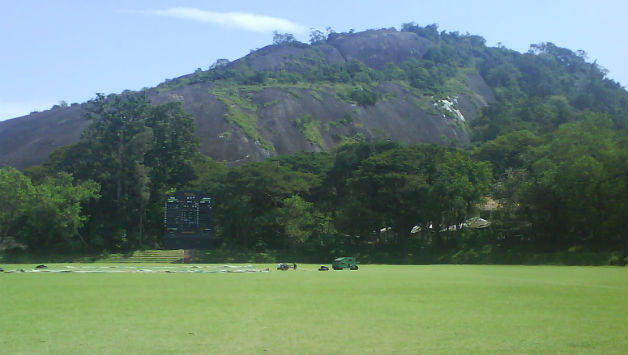Rajitha Amunugama: The First-Class Cricketer With Most Initials
Beyond USA June 4, 2015 admin 0

Amunugama played most of his First-Class matches at Welagedara Stadium. Photo Courtesy: Wikimedia Commons
By Abhishek Mukherjee
Amunugama Rajapakse Rajakaruna Abeykoon Panditha Wasalamudiyanse Ralahamilage Rajitha Krishantha Bandara Amunugama was born April 12, 1969. Abhishek Mukherjee looks back at the First-Class cricketer with the most initials.
Amunugama Rajapakse Rajakaruna Abeykoon Panditha Wasalamudiyanse Ralahamilage Rajitha Krishantha Bandara Amunugama, to put things simply, holds the record for most initials of a First-Class cricketer. Probably out of mercy towards scorers and statisticians across the world, he had abbreviated his full name to Rajitha Amunugama, but scorecards still carry an emphatic ARRAPWRRKB Amunugama.
Note: Some sources cite the eighth word of the name as Ranjith, and Ranjith Amunugama is used as the full name.
When he came across the name, Matthew Engel wrote in Wisden 2004: “With ten initials, he [Amunugama] has now established a commanding lead over his nearest rival, AKTDGLAS de Silva.” Engel was referring to Arya Kastriya Takurartiya Dawaditya Gadyawasam Lidamullage Asitha Suraj de Silva, the man Amunugama had gone past.
Amunugama had also made it to Wisden, in 1991, but as an innocuous RKB Amunugama. Engel famously joked on the increase in initials: “Is this an elaborate joke, along the lines of Llanfairpwllgwyngyllgogerychwyrndrobwllllantysiliogogogoch? Wisden‘s policy is that players may suppress embarrassing middle names if they wish without fear of being outed by researchers bearing birth certificates, and the reverse should also apply (after all, Bob Willis added the middle name Dylan). But our patience is not infinite. You can call yourself what you like — but not if we have to omit the Laws of Cricket again just to make room.”
Lawrence Booth lamented in Arm-ball to Zooter: A Sideways Look at the Language of Cricket: “Despite the best efforts of Ranjith’s mom and dad, the selectors stubbornly refuse to offer him the Sri Lankan captaincy.” In Zimmer Men: The Trials and Tribulations of the Ageing Cricketer, Marcus Berkmann mentioned that he would be rooting for Amunugama if the latter ever won a Test cap.
Amunugama also finds a mention in Chinaman, that masterpiece by Shehan Karunatilaka. Here is an excerpt from the section called Long Names: “Contrary to popular belief, most pages of Colombo’s phone book are taken up by shorter Portuguese derivatives like de Silva, Perera and Fernando. That said, Sri Lanka has also produced leg-spinner Ellawalakankanamge Asoka de Silva and ARRAPWRRKB Amunugama. I was going to type out his entire name, but life is too short, mine especially.”
However, besides being a favourite for trivia buffs, Amunugama had an impressive career as well. A medium-pacer, Amunugama played 102 First-Class matches and claimed 237 wickets at 26.91 and a strike rate of 45.8 with 8 five-fors and a ten-wicket haul.
Career
Amunugama was good enough to be selected for Sri Lanka Schools, and was later picked for Sri Lanka Young Cricketers in the Youth World Cup 1987-88. He played two matches, against New Zealand Young Cricketers and ICC Associates Young Cricketers, without doing anything spectacular. The Sri Lankans finished fifth, and did not make it to the semi-finals.
He made his First-Class debut for Tamil Union against Sinhalese Sports Club (SSC) in 1989, and impressed with 3 for 89. It was in 1990, however, that his first major feat came — at Moratuwa. He wrecked Sebastianites for 94 and 133 with figures of 4 for 32 and 8 for 60. It led to his first appearance on Wisden, albeit as RKB Amunugama, as mentioned above.
He moved to Kurunegala in 1994-95, and turned out to be a revelation. Unfortunately for Amunugama, Sri Lankan cricket was on the rise under Arjuna Ranatunga; with Sri Lanka opting for a two-seamer strategy in most cases and Chaminda Vaas sealing the first seamer’s spot, Amunugama was never in contention.
His batting improved at this point. Against Panadura he took 5 for 115, but Kurunegala followed on, 160 runs behind. Walking out at 174 for 6 he held on, adding 40 with Hiran Liyanage to save the match. In the next match, against Moors Sports Club, Amunugama followed his 5 for 74 with 52 not out.
In those days Kurunegala used to be a scorer’s nightmare: against Kalutara in 1996-97 they fielded SNRHMSB (Senadi Malmeewala), JAMW (Wasantha) Kumara, MAWR (Ranjith) Madurasinghe, and HMRKB (Rangana) Herath together, in addition to the most emphatic of them all — ARRAPWRRKB Amunugama.
Amunugama was also good enough to feature for North-Western Province on a regular basis. Though he never had a string of poor performances on the trot, he never had an exceptional phase in his career. His last quality performance came against Ragama in 2001-02, when he claimed 7 for 47.
He retired after 2003-04. He played a season for Gore Court in 2004, where he played six matches, taking 10 wickets at 19.10 and an excellent economy rate of 3.41. Following that he quit from all sorts of cricket.
(Abhishek Mukherjee is the Chief Editor and Cricket Historian at CricketCountry. He blogs here and can be followed on Twitter here.)
The above article is reproduced with permission from cricketcountry.com



